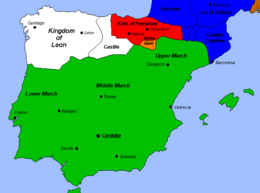Lower March
The Lower March (Arabic: الثغر الأدنى, al-Ṯaḡr al-ʾAdnā) was a march of the Al-Andalus. It included territory that is now in Portugal.[1]

As a borderland territory, it was home to the so-called muwalladun or indigenous converts and their descendants, some of these eventually established dynastic lordship such as the case of Ibn Marwan al-Jilliqi who ruled the Cora of Merida during the early part of the ninth century, a region with its capital in modern Merida and included the area of modern Badajoz.[2] Several rebellions occurred in the territory, most notably caused by Umar ibn Hafsun and two of his sons refusing to recognize the Emir of Cordoba's sovereignty;[3] even after Hafsun's death, small pockets of independent resistance persisted.[3] It was not until a decade after Hafsun's demise that the Emir of Cordoba was able to completely quell the rebellion in the Lower March.[3]
References
- António Henrique R. de Oliveira Marques, Mário Soares (1998). "Histoire du Portugal et de son empire colonial". Histoire du Portugal et de son empire colonial (in French). KARTHALA Editions. Retrieved 2011-12-09.
- Safran, Janina (2013). Defining Boundaries in al-Andalus: Muslims, Christians, and Jews in Islamic Iberia. Ithaca, NY: Cornell University Press. p. 172. ISBN 9780801451836.
- Flood, Timothy M. (2018). Rulers and Realms in Medieval Iberia, 711–1492. Jefferson, NC: McFarland. p. 45. ISBN 9781476674711.